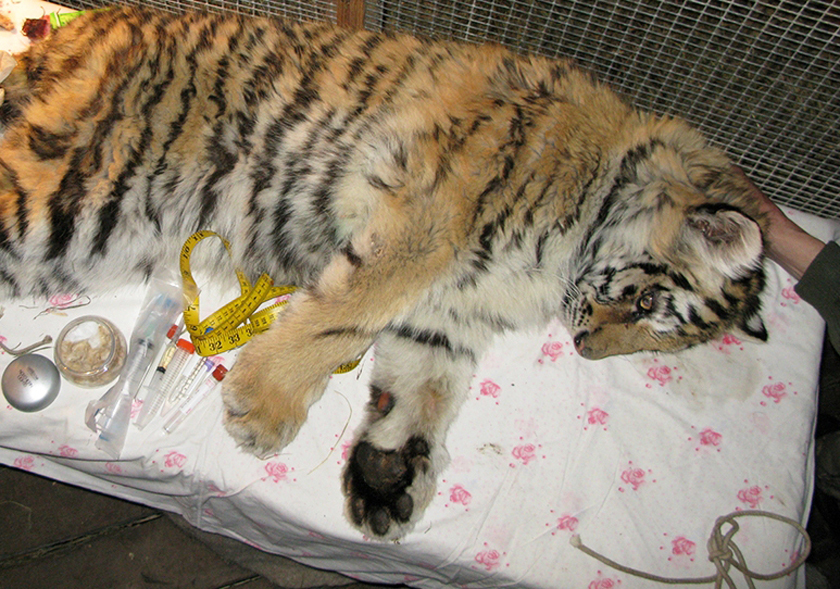From Orphaned, Frostbitten Cub To Fearless ‘Tiger Princess’
Great tiger news this month as one fierce test-case orphan makes it on her own in the Russian Far East, and the big cat census is on the rise in India.
By Vicki Croke
Vicki spoke with Here & Now’s Jeremy Hobson about good tiger news in Russia and India.
Zolushka, once orphaned, and now healthy, and recolonizing a tigerless forest, may prove to be the perfect model for saving Amur tigers. Courtesy: WCS.
From the success story of an orphaned tiger cub in the Russian Far East—a possible model for tiger conservation everywhere—to the uptick in tiger numbers in India, this is a good month for tigers.
The story of the orphaned cub is so entrancing, in fact, that big cat biologists are comparing it to a fairytale. In it, not only is an orphaned cub saved, but she, in turn, may save a whole forested area–filling it with the tigers who once roamed here.
The tiger is a female named Zolushka—which is the Russian equivalent of Cinderella. Two hunters found her in the winter of 2012—alone, starving, and frostbitten. She was an almost dead tiger cub—really not much more than a striped bag of bones lying in snow.
She’d been orphaned—her mother probably killed by poachers.
Zolushka was starving, alone, and near death when hunters discovered her and carried her to a wildlife officer. Biologists had to amputate part of her frostbitten tail. Courtesy: WCS.
Taking pity on her, the hunters threw a coat over the nearly lifeless cat, and carried her to the local wildlife inspector, who fed and protected her. The official called upon Dale Miquelle, a top cat in the world of tiger biologists, who runs the Russia program for the Wildlife Conservation Society, and has been tracking and studying these animals since the early 1990s.
The 4-month-old tiger was anesthetized and treated, having much of her frostbitten, blackened tail amputated.
Her next stop, a brand-new rehabilitation center, helped her regain her tigerness. Zolushka was treated to a vast outward-bound kind of boot camp in the Russian Far East forest where she had minimal—or no–contact with humans, and maximum exposure to prey animals.
The Bronx Zoo (part of the Wildlife Conservation Society) helped design the fence system for the tiger rehabilitation center (ПРОО “Центр “Тигр” / PRNCO “Tiger Center”) in Russia. Courtesy: Tara Harris.
Here, in a fenced in and protected environment, she learned to hunt and to cache her food, burying leftovers in the snow.
And in May 2013, when it looked like she was ready–tigers leave their mothers at about the age of 18 months, Miquelle says– biologists brought her to the Bastak Nature Reserve in the Russian Far East. The reserve—because of habitat loss and poaching, hadn’t seen tigers in 40 years.
Now better protected, the reserve was just waiting the return of tigers. And Zolushka hit the ground running (literally, as you can see from some spectacular slow-motion video provided by another conservation group involved in the project—the International Fund for Animal Welfare).
There was evidence right away that she killed and ate a badger, and then shortly after that she brought down a wild boar. Proving she’s a pretty tough, hard-core kind of Cinderella. If she were human, she’d be more comfortable in ice cleats than glass slippers.
[youtube=http://youtu.be/wDkZEUGRzMQ?t=2m12s]
Watch Zolushka leap to freedom in this slow-motion video taken by members of the International Fund for Animal Welfare.
Zolushka may very well turn out to be a model for tiger release. And she is among several cats—including the so-called “Putin tiger,” (a tiger released from Zolushka’s rehab facility who made headlines when he wandered into China), released in 2014. They are all part of an effort to reverse the decline in tigers here. In that regard, Zolushka seems to be doing her part by taking up with a male.
WCS’s Dale Miquelle says:
“Zolushka or Cinderella recently has met her prince, meaning that a male tiger has wandered into this area from quite far away. Somehow he showed up in the same area where Zolushka is. And so the prince has found Cinderella and we found them traveling together over the last year. She’s still young, she’s still very much a princess but we’re hopeful in the very near future that she’s going to produce cubs. And so again this is a story not just about one young tigress surviving and returning to the wild, but about recolonizing an area where tigers no longer exist.”
It’s a promising commencement. And an important one. There are only about 400 to 500 of these tigers in the Russian Far East.
A clear view of the decline of tigers: Historic versus current range. Courtesy: Panthera.
Zolushka is three-and-a-half years old—that’s about the start of breeding age—and there are hopes that the camera traps in the reserve might collect some pictures of Zolushka with a young cub or two.
The chances are in her favor. Dale Miquelle of WCS says that the area is better protected now, and it continues to have very high densities of prey—wild boar and red deer—so there’s plenty to eat there. And just as that male tiger found his way in, there are bound to be others.
Though she is something of a first, there are other orphaned Amur, or Siberian, tiger cubs who’ve been released, or in the pipeline going through rehabilitation just like Zolushka. These cats may end up making a significant contribution to tiger numbers over time. A new census is starting now and it’s hoped it will show an increase in the overall population.
It won’t matter how we refer to them, but it’s interesting to note that while many of us have grown up calling Russian tigers Siberian tigers, today scientists refer to them as Amur tigers—after a very large river which is central to their habitat.
Camera trap photo of Zolushka with radio collar. Tiger man Dale Miquelle says Amur tigers are actually a little smaller than Bengal tigers. But at 430 pounds for a big male and about 240 pounds for a female, the Amur tiger is, as Miquelle says, “still a lot of cat.” Courtesy: WCS.
Dale Miquelle explains, “Probably the Amur tiger is more accurate from a scientific perspective,” he says. “Actually, Siberian tigers don’t live in Siberia, which is a little ironic. This part of Russia is called the Far East. Siberia is really the central core of Russia. We’re outside of the area Russians call Siberia. And Amur tigers really never lived in Siberia.”
In India, there is good tiger news too (though some biologists are questioning the methodology used, and the figures might end up getting toned down).
A new government census came out just days ago showing that the tiger population in India has grown by 30 percent in just four years—up to 2,226. Less than 10 years ago, that number was only about 1,400. So, if that number stands, or anything close to it, we’re still talking about a significant increase.
Officials attribute the increase mainly to the efforts to fight poaching.
But there have also been expanded efforts to find and rehabilitate orphaned cubs, to pay people to relocate out of protected tiger areas, and to increase tiger “corridors”—safe passageways connecting tiger habitat.
Several snarls served as the best thank you–listen as Zolushka, spitting-mad, is set free. Members of the International Fund for Animal Welfare recorded the moment. Photo and sound courtesy: IFAW.
India has 70 percent of the world’s tiger population. So when they’re doing well there, it’s significant. The big cat conservation group—Panthera —estimates that there are fewer than 3,500 tigers in the entire world. Even 100 years ago, it’s believed that number was more like 100,000. (According to Panthera, tigers live in less than 7 percent of their historic range, and three subspecies— the Javan, Caspian, and Bali— have gone extinct in the last 80 years.) That’s tough stuff. The biggest cat. The biggest threat of extinction. But it makes the news from India especially heartening since conservationists think that upward trend stands a good chance of continuing. Claiming they could add another 1,500 in the next decade. And as Zolushka shows us—every tiger counts.







11 Responses to “From Orphaned, Frostbitten Cub To Fearless ‘Tiger Princess’”
A emotional and heart warming story.
Thank you for care and saving her. I hope she will have a wonderful long life without poachers. Blessings
Absolutely fabulous to see these babies growing again, the world wouldn’t be the same without these beautiful cats, well done, and thank you to all the guy’s who put their ‘all’ to keep our tigers safe & well xx
Beautiful, but I can’t help but worry that the market for Tiger parts, AKA “China”, will somehow find this wonderful creature and end her new freedom.
dale why must you continue to radio collar tigers when it’s by now common knowledge that GPS collars are too large and impede tigers from a normal life? Snaring them to catch them is a whole separate reason why at this critical point in time conservation is more important than science. You and John Goodrich have collared more than 80 tigers – don’t you know enough by now to just leave them alone ?
The collars fall off in about 12 mos.
What a beautiful picture. …her release back into the wild! Such a Heart-warming story(thanks for sharing)…..such beautiful and majestic creatures. They should be able to enjoy their lives without poachers.
Amazing
Governments should offer some kind of reward/incentive for people bringing in hurt/abandoned/dying animals (you’d be naturally suspicious if the same person kept showing up…). Kudos to those hunters who brought the cub to the sanctuary.
I have been waiting for some news on Zolushka. It is wonderful to hear she is doing well. My concern right now is to not disclose the areas she has been , for good reason: the market for tigers and their parts is high. She needs to be as safe as possible if she is to thrive.
I’ve been concerned about a forever collar [regular collars for domestic cats are bad] so I was glad to learn these Tygers collar are for app. 1 year…
Comments are closed.